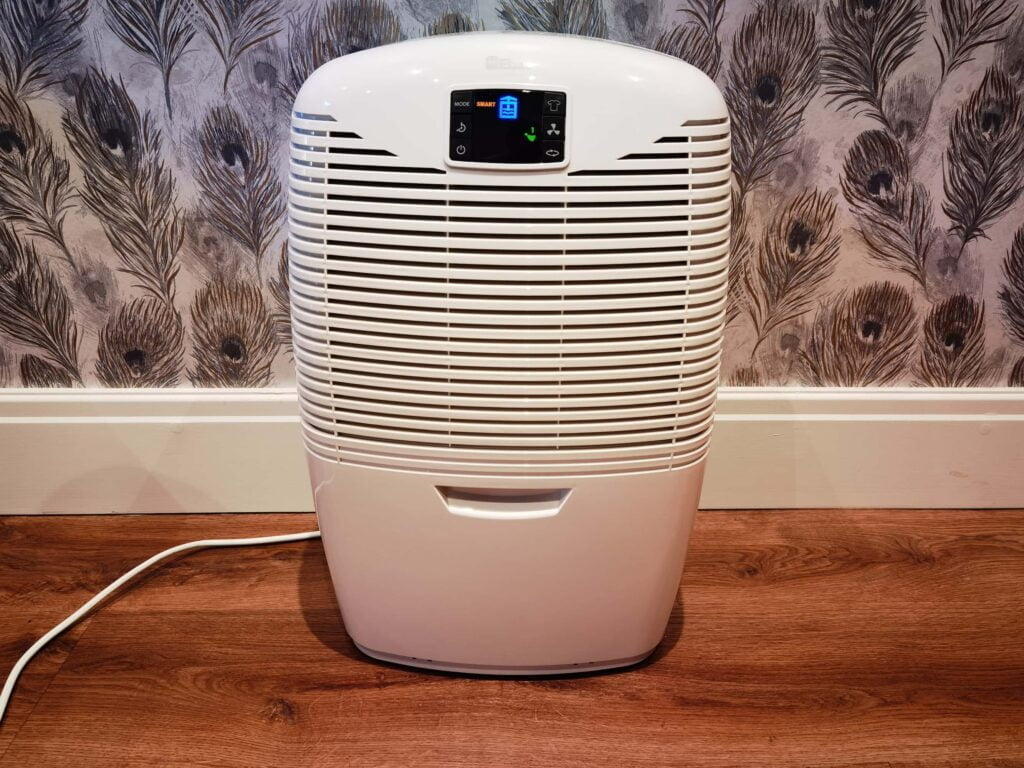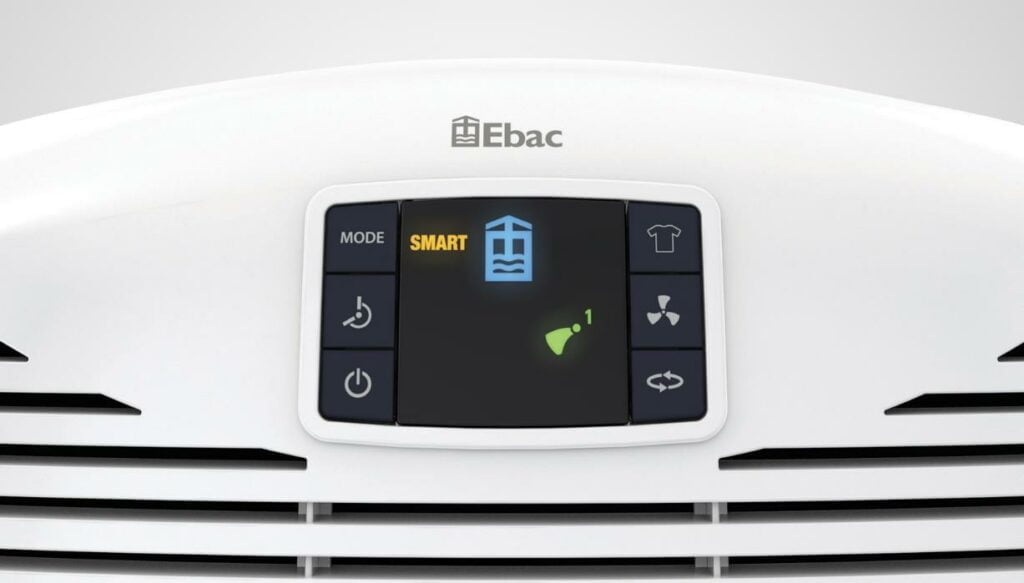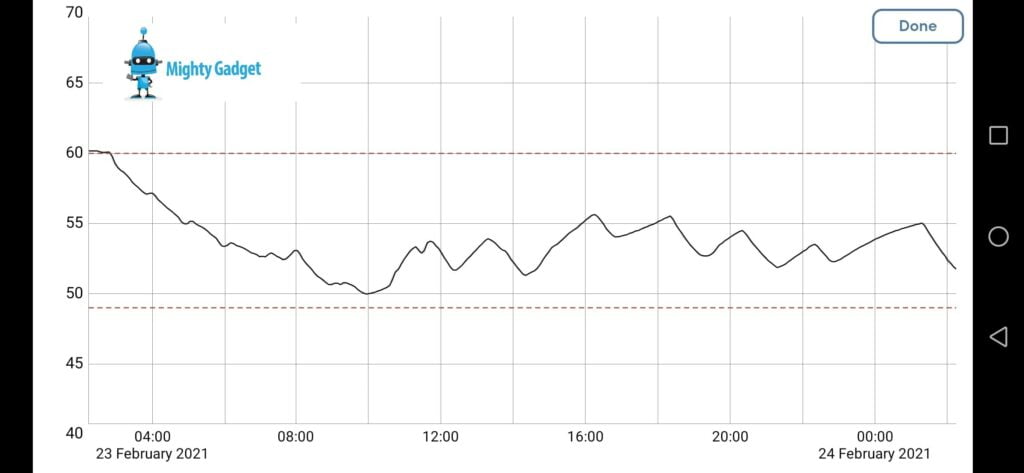I became a bit obsessed with air quality last year, I have found improving indoor air quality has reduced a lot of my issues with breathing.
One factor in this is humidity levels. Too high and you promote the growth of mould, too low, and it can dry out your sinuses and cause other issues. Living in the north of England in an old house also means condensation and damp are common things.
The Ebac 3850e Smart Control Dehumidifier sits at the top of the product range from the UK brand. It is not quite smart in the smart home sense I would normally write about, but its smart humidity control gives it an advantage over many competing brands.
This is a compressor-style dehumidifier. It is a bit more old fashioned than the desiccant that has gained popularity. However, Ebac is adamant that it is a superior option for UK homes offering significantly lower running costs.
About Ebac
Established in the 70’s, Ebac is a British manufacturer of dehumidifiers, washing machines and water coolers. They manufacture their products in County Durham, making them the only UK based manufacturer of washing machines and one of the few in the home appliance segment in general.
With many people being pro-Brexit, and the general trend of political beliefs in recent years. Ebac should be at the top of the list for many people when buying white goods.
Desiccant vs Refrigerant Compressor Dehumidifiers
Compressor
Compressor dehumidifiers are the more traditional style of dehumidifiers. They work like a fridge, cooling air and having it condense on its coils. When the water is extracted, it warms up the air over some heat coils. It is a simple and effective way of dealing with things, and the power used to run them is very low.
They have a few downsides though, because it needs to cool air down to its dew point, the lower the ambient air, the lower the temperature the compressor needs to go. This can cause ice build-up, so at low temperatures, the dehumidifier starts spending time and energy in defrosting itself.
The compressor itself is also quite noisy, and heavy.
Desiccant
Desiccant dehumidifiers are newer, and for years they have gained traction against the compressor as they are lighter, work well in a wide range of temperatures, often reduce humidity quicker and are quieter.
The work using a desiccant wheel which acts as a sponge, this needs heating to refresh it so it can carry on working. The issue is that it uses a massive amount of electricity to run when it is in operation.
So in more recent years, as we have become more energy conscious, they have started to fall out of fashion a little bit.
One major argument for the poor power efficiency of desiccant dehumidifies is that that also raise the temperature of the room. So you offset some of the cost in heating. With people using dehumidifies during the winter more, this seems like an appealing choice, but I think it is clutching at strings to justify the poor efficiency,
Ebac vs Which?
Ebac really don’t like the Which? Review process. They claim:
- Which? prioritise high extraction rate as the most important factor when buying a dehumidifier.
- Which? mislead consumers on dehumidifier running costs by not showing comparative data on water extracted per KWh.
- Which? place little importance on the critical factor of control systems and how poor control further increases running costs
Basically, the Which? system favours desiccant products because they extract more water by volume. Ebac claim this is a poor way to assess things because UK homes don’t need to extract a lot of water; they just need to maintain a healthy humidity. Extracting litres of water a day burns through electricity.
It is a dispute that is a little too complex for me to weigh in on, but I can certainly appreciate the argument put forward by Ebac. You can read more about the dehumidifier dispute here. They are also not too happy about the way Which? evaluates washing machines.
Ebac 3850e Smart Control Specification
Ebac 3850e Most Powerful 21 Litre Dehumidifier for…
- Problem solved – eliminates condensation,…
- Made in Britain for the cold and wet British…
- Our most powerful dehumidifier – 21 litre…
- Exclusive energy saving Smart Technology…
£287.89

- High Quality Compressor – Reduces vibration and increases reliability
- Low Power – 160W on Power Consumption
- Low CO2 – 87% of component made in the UK, cut Carbon Footprint from importing
- Hydrophilic Coated Coils -Improves the efficiency of the water extraction from the air and increases water removed per KWh
- Integrated Handles – Easy to move around your home
- Strong ABS Polymer Chassis – No metal parts can rust, strong and durable
- Easy Pour Water Container
- Easy to hold and empty water container, fully enclosed
- Quiet Mode – Perfect for night time operation
- Permanent Drain Option – Drain the dehumidifier to a sink or outside and it never needs to be emptied
- Castor Options – Allows the dehumidifier to be wheels around your home
- Container Full Indicator Light- Light indicates when the dehumidifier needs to be emptied
- Boost Mode – Maximum power to deal with urgent issues
- Air Purification Mode – Cleans the air to remove dust, allergens and pollen
- Intelligent Defrost -Maximises uptime and improves efficiency
21 Litre Extraction Rate is Unlikely to Happen
It is worth noting that this is rated at 21 litres of extraction. Speaking to Ebac, they don’t like using these numbers, but everyone in the industry does it so they have to play the game.
Extraction rate numbers are listed base on a room temperature of 30°C and an 80% relative humidity. It is unlikely any UK home will ever experience such conditions.
All brands do this. It is a bit like the ridiculous numbers that get advertised for WiFi routers
Meaco actual publish their extraction rate data. The Meaco 20L Low Energy Dehumidifier with 30°C and 80%rh achieves 20.38 litres per day.
At 20°C and 60%rh, this drops down to just 8.48 litres per day.
Then 10°C and 60%rh it is 2.52 litres per day
I would expect similar sort of numbers from the Ebac. With it running on smart mode, switching on and off as it hits the ideal humidity levels, it is likely you will only need to empty the canister every couple of days.
Smart Control

Writing about smart home tech, the smart control isn’t quite what I may have expected with the Ebac. There is no WiFi or app control. The smart control is specifically about the automatic control of the dehumidifier.
- Ebac have developed a way of controlling your dehumidifier, called Smart Control.
Smart Control is an intelligent electronic software that replaces a normal humidistat. - Smart Control is unique as it takes readings throughout the day, allowing it to determine, with an algorithm, the best time to run. The optimum relative humidity varies depending on the activities within your home and the weather outside. As the optimum relative humidity changes, this means you would need to change the humidistat on your dehumidifier regularly; some dehumidifiers only have settings that are in 5% steps. This would mean that if the optimum is 47% you could chose 50%, which means the dehumidifier will not run enough, or you could chose 45% it means the dehumidifier is running too much.
- Smart Control is more effective at eliminating condensation and damp; it’s also more energy efficient and can save about half of your running costs, between £30 & £50 per annum.
- Smart Control is fully automatic. Once you switch your dehumidifier on and select Smart Control, you don’t need to make any adjustments to the controls; it simply runs and sleeps when it needs to.
Ebac 3850e In use vs EcoAir DD1 Simple Desiccant Dehumidifier
Like many, when I first looked into dehumidifiers, I was lured into the performance aspects of desiccant dehumidifiers. This led me to the EcoAir DD1, which has been an Amazon favourite for many years, being on the site for around a decade. So during my review, I have switched between the two options to try and work out which is the best solution.
Energy Use
Desiccant dehumidifiers have started to fall out of fashion as we have become more energy conscious. They use an insane amount of energy. The EcoAir DD1 at full blast uses 655W of electricity; switching to the eco setting drops this to 355W.
The Ebac 3850e, in its standard Smart mode uses 165W.
Then the three other options available used the same 175W of energy. This included:
- Setting the fan level to 2
- Using it in Max mode
- Using the clothes drying option
They options are clearly all identical in what they do, its just the difference on if/when the fan and energy level drops back down.
Noise
I am sensitive to certain noises and hate irritating background noises. All dehumidifiers make noise because they all use a fan. Fan noise has been the bane of my life, from computer fans to traditional fans while trying to sleep.
The Ebac 3850e doubles down on the noise it emits by introducing a compressor noise. It identical to the noise a fridge makes but perhaps louder.
When I first used it in the office, I immediately put on some earphones, knowing I could never cope with it.
It does settle down a bit, and you do get used it. The fan noise is lower than the EcoAir, and the compressor noise isn’t very loud, but it’s a more annoying noise than a fan due to the inconsistent sound pattern.
For me, neither device is ideal for a quiet room, I certainly couldn’t use either in a room I was trying to sleep in. Your mileage may vary.
Thankfully, unlike a fan, you don’t need a dehumidifier in the same room. Humidity levels equalise out throughout your home, so reducing it in one room will help others. Placing this in the hallway of my home should still offer effective dehumidifying of my bedroom and office.
Humidity Levels – Garage/Gym vs Office
I originally put the Ebac 3850e in my converted garage, which is now a gym. The room is only partially insulated, I am incredibly sweaty, and cycling in Zwift often leaves sweat steaming off me and puddles on the floor.
When I placed it in the gym, it was during the recent cold snap and I hadn’t put much thought into what I was doing. During this time, it didn’t do much. With temperatures sitting closer to 0-degrees than 10-degrees, a refrigerant-based dehumidifier was never going to achieve much. As the temperature outside warmed up, so did the performance of the dehumidifier.
The Ebac has an operating temperature from 3°C, but I suspect its performance isn’t the best at this temperature.
When I used to use the EcoAir in there, it would run until the reservoir was full, with poor insulation the dehumidifier was just sucking in the moist air from outside. At 650W+ per hour, that makes a big difference on the electricity bill.

Moving things into my office, I ran the two dehumidifiers over a couple of days to see how different they would be.
The EcoAir has a relative humidity setting, I set it to around half, which seems to take the humidity down to about 50%
You have no such option with the Ebac. Instead, the smart setting appears to keep things between 50% and 55%, which is the middle ground of the recommended room humidity levels. According to the smart control description, this humidity level will automatically adjust based on various factors.
Dew Point & Mould Risk @ 50% Relative Humidty
My office is generally cool, sitting at around 16°C to 17°C. At 17°C a relative humidity of 50%, the dew point is 6°C, and this increases to 8°C at 55%. There is no mould risk within this range, nor is there a risk of material decay.
The Ebac 3850e appears to do a better job at managing the humidity levels within that 5% range, it typically keeps things consistent at around 50/51%
The EcoAir performed better than I expected, working reasonably well at maintaining about 50%.
Running Costs
Comparing running costs is a little hard. The Ebac 3850e is definitely cheaper, it may run for longer, but it uses a quarter of the electricity when it is on. During my few days of use in the office, when the weather has just warmed up, there wasn’t a lot of work for either dehumidifier to do, so the running cost difference is a few pence.
Price and Alternative Options
| Preview | Product | Price | |
|---|---|---|---|
 |
Ebac 3850e Most Powerful 21 Litre Dehumidifier for… | £287.89 | Buy on Amazon |
 |
Meaco 20L LE Low Energy Dehumidifier, Ideal For Condensation | £227.94 | Buy on Amazon |
The Ebac 3850e is £288.89 on Amazon and the same price direct from Ebac. Direct from them; they have a 30-day no quibble returns policy.
The Meaco 20L Low Energy seems to be a popular choice at a similar price point to the Ebac. The big difference is the smart control, the Meaco can be manually set from 30 to 80%rh is 5%rh steps, but this sort of setting options reduces the overall efficiency
Overall
I am not sure if there can be a best dehumidifier for all scenarios. There is a very strong argument for using compressor dehumidifiers over a desiccant. The low power use is a massive advantage for them, even though they may run longer than a desiccant, the overall power usage is less.
A compressor dehumidifier seems like a logical choice if you want to run it constantly within your house. It should maintain humidity levels while keeping costs low.
The Ebac 3850e takes things up a notch with its no-touch smart control, which will intelligently adjust the ideal humidity based on the current conditions. This makes it perfect if you either have persistent humidity/damp issues or if you need to maintain a humidity level for health needs.
Overall, the Ebac 3850e dehumidifier is excellent. I like that you can just set and forget without the worry about high running costs.
The upfront cost is quite high, being one of the most expensive consumer options on the market, but these things should last decades, so the low running costs should justify the up front price.
Posted by Mighty Gadget Blog: UK Technology News and Reviews